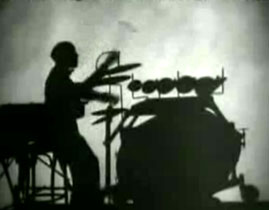 Behind the opening title cards we hear a rough & rugged muted trumpet solo of great & gritty merit, for the one-reel Vitaphone "Melody Masters" jazz film, Jimmie Lunceford & His Orchestra (1936). Behind the opening title cards we hear a rough & rugged muted trumpet solo of great & gritty merit, for the one-reel Vitaphone "Melody Masters" jazz film, Jimmie Lunceford & His Orchestra (1936).
The trumpet solo fades with the title card, & we see a volcanic crater ablaze. A slow tune is playing on the soundtrack, so a devil climbs up to the rim of the volcano & calls out pleadingly, "Rhythm! Hot rhythm! Where are you?"
The devil gives a little introductory rhymn & verse, then begins Saul Chaplin & Sammy Cahn's hot jazz number "Rhythm Coming to Life Again."
The unnamed lead vocalist in devil costume (could it be Dan Grissom?) gives a nice ragtime performance.
Silhouettes of the orchestra players begin to appear all around the devil & his firepit, playing into a common sentiment of the era that jazz was the devil's music, said with malice by those who didn't like it, embraced as a joke by those who did.
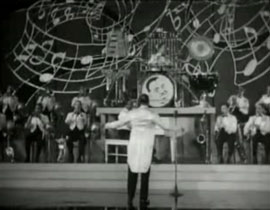 Jump-cut to the Lunceford orchestra on a much more regualr stage. Jimmy gives a quick introduction, "Let me tell you, 'Rhythm is Our Business,'" & the band strikes up the tune of that name, written by Sammy Cahn, Saul Chaplin, & Jimmie Lunceford. Jump-cut to the Lunceford orchestra on a much more regualr stage. Jimmy gives a quick introduction, "Let me tell you, 'Rhythm is Our Business,'" & the band strikes up the tune of that name, written by Sammy Cahn, Saul Chaplin, & Jimmie Lunceford.
It's once again a great piece of hot jazz. Willie Smith stands from the front row of the orchestra & leaving his sax behind, strolls to the mic-stand, leans it toward himself, & sings: "Rhythm is our business/ Rhythm is what we sell/ Rhythm is our business/ Business sure is swell..."
A verse addresses the "tricks with sticks" drummer as we get a big solo moment for Jimmie Crawford, who we'd early seen in silhouette starting up the devil's tune. He & his kit are mounted on a veritable pedistal above the band. He's highlighted throughout as a star in his own rite.
The next verse highlights the skills of Earl "Jock" Carruthers on saxophone, with a nice baritone sax solo. Moses Allen on double-bass is next introduced by the lyric, & gets a lovely solo moment.
The final verse gives Paul Thomas on trumpet his moment to glow, introduced by Willie's singing: "He blows on that trumpet in the band/ Paul blows on that trumpet in the band/ Now he's that guy who hits them high/ Makes you think he's in the sky!" then high-note trumpeted jazz arises.
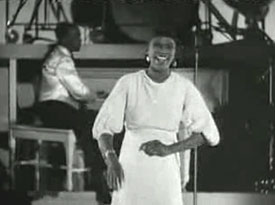 "And now that personality girl, Myra Johnson," says Jimmie Lunceford. She's about to sing "You Can't Pull the Wool Over My Eyes" by Milton Ager, Charles Newman & Murray Mencher. "And now that personality girl, Myra Johnson," says Jimmie Lunceford. She's about to sing "You Can't Pull the Wool Over My Eyes" by Milton Ager, Charles Newman & Murray Mencher.
Myra does a dance-step to center stage, tossing her arms about loosely as she sings: "You can't pull the wool over my eyes/ You can't get away telling those lies/ You're not the way you used to be/ I got eyes that I can see/ You've been stepping out on me/ What a surprise..."
She has a tremendously good voice & indeed a "personality girl" taking command of the number so that you can't take your eyes off her, plus she wiggles with such sexy playfulness.
"And now," says Jimmy simply, "the Three Brown Jacks." The tapdance trio will perform to the Sherman & Chester Wallace composition "Moonlight on the Ganges." It's a very likeable dance interlude, with musicality in their feet.
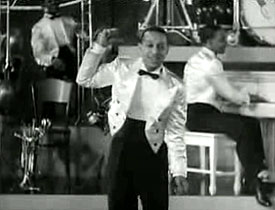 Jimmie next says by way of introduction of the next number, "Maybe you'll remember this one," & strikes up the Harry Warren & Mort Dixon number "Nagasaki." You know the number, "Down in Nagasaki where the fellas chew tobakky & the women wicky-wacky-woo." Jimmie next says by way of introduction of the next number, "Maybe you'll remember this one," & strikes up the Harry Warren & Mort Dixon number "Nagasaki." You know the number, "Down in Nagasaki where the fellas chew tobakky & the women wicky-wacky-woo."
A great number, performed full throttle top speed, with trumpeter Eddie Tompkins leaving his horn behind as he rushes forth from the band center stage for the lyrics. From the background you can sometimes hear Sy Oliver calling out little vocal comments, then the camera settles on him as he rubs his hand & continues asking questions which the lyrics of the song answer. Hot damn but I wish I could go to a club this evening & see something this good!
This arrangement & performance is so good it's just jaw-dropping. When Eddie runs back to his seat in the orchestra, with hardly a break the whole orchestra begins playing the hot, hot Will Hudson number "Jazznochracy."
Joe Thomas gets a big alto sax solo, & the whole band cuts loose in support. Fellow saxman Earl Carruthers along with Joe Thomas, tall guy & short guy, rush forward center stage still holding their saxes, & perform a dance routine together infused with humor & spectacular talent, their joint personality outshining the Three Brown Jacks I'm afraid.
Paul Webster gets one of his high-note solos, surrounded by other trumpeters & slide trumbones. Drummer Jimmie Crawford with a big mallot is playing a wooden chair! Good god all mighty we are entertained at last!
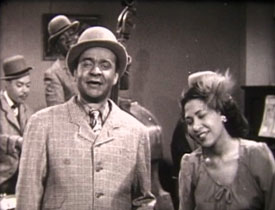 Johnny & George were a black singing duo who did three soundies in 1945, including I Had a Dream. Johnny & George were a black singing duo who did three soundies in 1945, including I Had a Dream.
The duo sang regularly at the Apollo Theater & elsewhere, though it's pretty shocking they could keep getting work in days when great performers were numerous & crappy acts ought to be off in the hinterland begging to open for strippers in burlesque houses.
The duo's biggest claim to fame is that they were booked into a Catskills where they learned the Yiddish music hall number "Bei Mir Bist du Schon" composed by Sholom Secunda & Jacob Jacobs. They gave it a few English words, & added it to their act. A Yiddish music hall number done by black guys in swing tempo was quite the novelty.
When they performed it at the Apollo a couple years later, there sat up in the balcony Sammy Cahn & Saul Chaplin.
Sammy immediately bought the rights from the duo for $30. They'd previously accepted $30 for other of their original material, & inevitably that was all it was worth. But this time, Sammy Cahn turned around & was able to get the Andrew Sisters to sing it, for whom it became a big hit by Christmas 1938: "I could say Bella Bella; even say Voonderbar/ Each language only helps me tell you how grand you are."
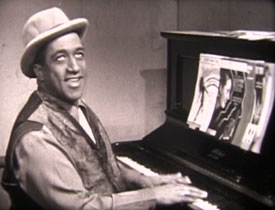 So Johnny & George's main claim to fame is they got screwed bigtime, their first brush with something successful & they sold it for thirty bucks. So Johnny & George's main claim to fame is they got screwed bigtime, their first brush with something successful & they sold it for thirty bucks.
Their secondary claim to fame is equally pitiful. When Tommy Gaither of the singing group the Orioles crashed his 1948 Dodge into a restaurant killing himself, Johnny & George were in the back seat, & were removed from the wreckage unconscious.
Their careers were so trivial that there seems to be no record anywhere of what their last names were.
Assisted by a tiny back-up band in the I Had a Dream soundie, either Johnny or George is working the piano. The setting is staged as a tavern, with a beautiful "sweetheart" beside the singer.
The other member of the duo, Johnny or George, stands wearing a bowler hat. He sings in a quavery massively anti-hipster voice: "I had a dream, dear, you had one too/ Mine was the best one because it was of you..."
It's an old tune meant to be sung by an a-capela barbershop group, not by a soloist. So even as a retro nostalgia number it just doesn't do much. The singer's an older gent who hardly seems plausibly an entertainer anyone would ever pay to see, though they do have a melancholy old-time vaudeville air about them as eternally down & out performers.
The awful little soundie becomes momentarily interesting when this guy stops singing & one of the several women in the bar begins to dance. She's not horrible, but the piano-lead by the other member of the duo hasn't much of a beat really, so she's having trouble doing much too it. The singer then picks up & concludes his miserable solo.
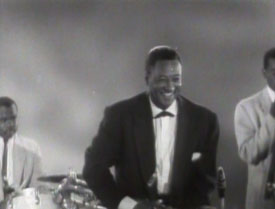 Paul Williams & His Hucklebuck Boys is how emcee Willie Bryant introduces Paul Williams' combo, in the three-minute Studio Films telescription My Love is True (1954).
Paul Williams & His Hucklebuck Boys is how emcee Willie Bryant introduces Paul Williams' combo, in the three-minute Studio Films telescription My Love is True (1954).
"Hucklebuck Boys" alludes to the band's 1949 crossover R & B hit "The Hucklebuck" which went in part: "Wiggle like an eel, waddle like a duck/ That's how you do the hucklebuck."
Their recording of this number included Paul's "honking" saxophone beat which he learned from Charlie Parker, & which Paul made so familiar in R & B circles that it became standard for a lot of roots-rock of the early 50s & pure rock 'n' role of the mid '50s & early '60s.
Virtually no one outside the jazz community knew the hucklebuck was actually a standing sexual position. A lot of black musicians must've been laughing their asses off when white stations started playing it. Its composer, Andy Gibson, called it "dirty boogie," but went no further in explaining what made it dirty so white DJs just assumed it described a style. The live performances of Paul & the Hucklebuckers were riddled with sexual innuendo, sometimes induced joyful lewd rioting, & got raided by police.
Williams called his band "the Hucklebuckers" but they're only billed as the Paul Williams Band in the Studio Productions films, & he's totally subdued.
It's seriously too darned bad Studio Films didn't have the nerve to capture on film some of the band's more notorious numbers, or at least give them a half-dozen starring telescriptions as they did for most of the performers filmed in 1954.
Williams' band is the back-up for many R & B singers recorded live in 1954 in a series of "telescriptions," films less than three minutes long each, to be arranged variously in half-hour clusters for play on television or longer groupings for theatrical release.
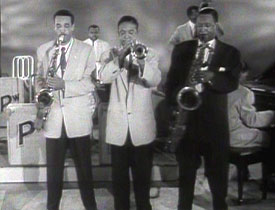 The presence of the Paul Williams combo was a boon for Studio Productions' telescription project. His was a skilled, adaptable band which could back just about anyone on short order. It's unfortunate the band was not given more opportunities to shine on its own; they are almost always relegated to the background. The presence of the Paul Williams combo was a boon for Studio Productions' telescription project. His was a skilled, adaptable band which could back just about anyone on short order. It's unfortunate the band was not given more opportunities to shine on its own; they are almost always relegated to the background.
But for My Love Is True, the combo gets its own great moment. Bryant asks Paul to stand up & take a bow; he's the sax man who always wears a different sort of suit to stand out in the band, this time a black suit with the rest of the guys in grey. Though he always likes to stand out in his attire, he's otherwise nearly without ego, & merely has his place in the band, not featuring himself in particular.
Bryant then introduces one of the band members, Jimmy Brown, bringing him down in front to do a number Jimmy personally composed. The two saxophonists, including Paul, also come forward to flank Jimmy, who has his trumpet handy.
Jimmy had a checkered past & had been the husband of singer Ruth Brown who made a set of telescriptions around the same time, though she & Jimmy had been divorced for two years by this time.
In the late '40s he & Ruth recorded some fine R & B numbers as "Brown & Brown." Jimmy had around the same time recorded "My Love Is True" for Atlantic, late in 1949 under the name Jimmy Earle, well before he joined the Hucklebuckers.
The three guys -- two saxes & trumpet -- play a great instrumental riff then Jimmy steps two paces forward, snapping his fingers, & performing his jump-jazz vocal very influenced by Louis Jordan. The saxes maintain the famed honking beat.
Jimmy steps back between the saxes for the instrumental, to blow a spectacular solo to the continuing honking saxes. He then steps forward anew for the closing lyrics.
This thrilling short film was included in Showtime at the Apollo: All Star Review (1955), together with older Snader telescriptions by Nat King Cole (Route 66, 1951), two by Lionel Hampton (Ding Dong Baby & Slide, Hamp, Slide, 1951), Sarah Vaughan (You're Not the Kind of Boy for Me, 1952) & Martha Davis (We Just Couldn't Say Goodbye, (1951). Another Studio Films telescription was included, Danny Boy (1954) by The Larks, plus schtick from comics Mantan Morland & Nipsey Russell.
copyright © by Paghat the Ratgirl
|
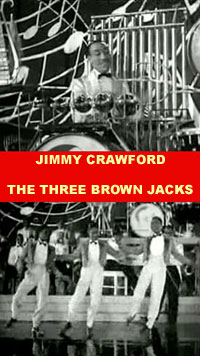

 Jump-cut to the Lunceford orchestra on a much more regualr stage. Jimmy gives a quick introduction, "Let me tell you, 'Rhythm is Our Business,'" & the band strikes up the tune of that name, written by Sammy Cahn, Saul Chaplin, & Jimmie Lunceford.
Jump-cut to the Lunceford orchestra on a much more regualr stage. Jimmy gives a quick introduction, "Let me tell you, 'Rhythm is Our Business,'" & the band strikes up the tune of that name, written by Sammy Cahn, Saul Chaplin, & Jimmie Lunceford. "And now that personality girl, Myra Johnson," says Jimmie Lunceford. She's about to sing "You Can't Pull the Wool Over My Eyes" by Milton Ager, Charles Newman & Murray Mencher.
"And now that personality girl, Myra Johnson," says Jimmie Lunceford. She's about to sing "You Can't Pull the Wool Over My Eyes" by Milton Ager, Charles Newman & Murray Mencher. Jimmie next says by way of introduction of the next number, "Maybe you'll remember this one," & strikes up the Harry Warren & Mort Dixon number "Nagasaki." You know the number, "Down in Nagasaki where the fellas chew tobakky & the women wicky-wacky-woo."
Jimmie next says by way of introduction of the next number, "Maybe you'll remember this one," & strikes up the Harry Warren & Mort Dixon number "Nagasaki." You know the number, "Down in Nagasaki where the fellas chew tobakky & the women wicky-wacky-woo."
 So Johnny & George's main claim to fame is they got screwed bigtime, their first brush with something successful & they sold it for thirty bucks.
So Johnny & George's main claim to fame is they got screwed bigtime, their first brush with something successful & they sold it for thirty bucks.
 The presence of the Paul Williams combo was a boon for Studio Productions' telescription project. His was a skilled, adaptable band which could back just about anyone on short order. It's unfortunate the band was not given more opportunities to shine on its own; they are almost always relegated to the background.
The presence of the Paul Williams combo was a boon for Studio Productions' telescription project. His was a skilled, adaptable band which could back just about anyone on short order. It's unfortunate the band was not given more opportunities to shine on its own; they are almost always relegated to the background.